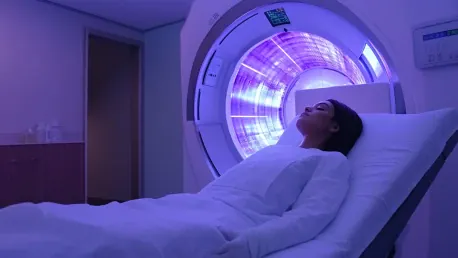Researchers at the National University of Singapore (NUS) have developed an innovative method to enhance the effectiveness of chemotherapy while mitigating its adverse side effects. This novel approach employs brief, localized pulses of magnetic fields, which significantly increase the uptake of doxorubicin (DOX), a widely utilized chemotherapy drug, into breast cancer cells, while exerting minimal impact on healthy tissues. This selective uptake enables more precise targeting of cancer cells, potentially improving treatment outcomes and diminishing the adverse effects typically linked with chemotherapy. The development promises a significant leap forward in cancer treatment, offering hope for more effective and less harmful therapeutic strategies for cancer patients.
Breakthrough in Chemotherapy Enhancement
The study, led by Associate Professor Alfredo Franco-Obregón, Principal Investigator at the Institute for Health Innovation & Technology (iHealthtech) at NUS, marks the first systematic investigation into how pulsed magnetic fields enhance DOX uptake in cancer cells. The team’s research findings were published in the journal Cancers on November 18, 2024. This work builds upon earlier research from 2022, which initially demonstrated that certain cancer cells are more susceptible to magnetic field therapy. This ongoing exploration symbolizes considerable progress in the pursuit of less invasive, yet highly effective, cancer treatments.
DOX is a prevalent chemotherapy drug for treating breast cancer. It operates by binding to DNA elements and disrupting cell replication and respiration, ultimately leading to cancer cell death. Despite its effectiveness, DOX is non-selective and can damage healthy tissues, causing side effects ranging from mild to severe, including cardiomyopathy and muscle atrophy. To address these challenges, the NUS researchers developed a novel approach using brief magnetic field pulses to selectively enhance DOX uptake into breast cancer cells. The research aimed not only to maintain DOX’s effectiveness but also to reduce its adverse impact on healthy tissues by precise targeting.
Role of TRPC1 in Targeted Drug Delivery
The study identified the critical role of a calcium ion channel known as TRPC1, which is frequently found in aggressive cancers, including breast cancer. Exposure to magnetic fields activates TRPC1, thereby enhancing its capacity to facilitate DOX entry into cancer cells. During their experiments, the researchers compared the effects of magnetic field therapy on human breast cancer cells and healthy muscle cells. They discovered that breast cancer cells absorbed significantly more DOX when exposed to magnetic pulses, whereas normal tissues were not as heavily targeted. This finding highlights the potential of magnetic fields in achieving selective drug delivery.
A 10-minute magnetic field exposure reduced the drug concentration necessary for a comparable level of cancer cell killing by half, particularly at low doses. In contrast, healthy muscle cells did not exhibit increased cell death when subjected to DOX and magnetic pulses, indicating enhanced protection for non-cancerous tissues. The team further demonstrated that reducing TRPC1 expression or inhibiting its activity negated this effect, thereby confirming the essential role of TRPC1 channels in the mechanism. The ability to selectively target cancer cells while shielding healthy tissues from harm represents a breakthrough that could transform chemotherapy treatment paradigms.
Promising Results and Future Implications
“What’s promising is that this mechanism works strongest at low drug concentrations, enabling us to target cancer cells more effectively while reducing the burden of chemotherapy on healthy tissues,” added Assoc Prof Franco-Obregón. With breast cancer remaining the leading cause of cancer-related deaths among women worldwide, the need for innovative treatment strategies is urgent. Research team member Assistant Professor Joline Lim emphasized the prevalent issue of chemotherapy-induced side effects, noting, “The majority of women who undergo chemotherapy experience side effects from treatment, and in some cases, doses of chemotherapy need to be reduced, or in severe cases, stopped prematurely.”
Moreover, prolonged exposure to high-dose chemotherapy can lead to drug resistance. This targeted approach represents a promising opportunity to potentially enhance treatment outcomes while preserving patients’ quality of life. The team’s magnetic-assisted approach addresses one of chemotherapy’s primary challenges — its toxic impact on healthy tissues. By selectively enhancing drug uptake into cancer cells, this method has the potential to drastically reduce the systemic side effects frequently experienced by breast cancer patients. The implications of such a method extend beyond improved efficacy, potentially leading to earlier adoption of chemotherapy by patients previously deterred by side effects.
Path to Clinical Application
Researchers at the National University of Singapore (NUS) have pioneered a groundbreaking technique to boost the efficacy of chemotherapy while reducing its negative side effects. This cutting-edge approach utilizes brief, targeted magnetic field pulses to enhance the uptake of doxorubicin (DOX), a commonly used chemotherapy drug, by breast cancer cells. Importantly, this method has minimal impact on healthy tissues, allowing for more precise targeting of cancerous cells. By facilitating selective uptake of the drug into cancer cells, this innovative technique holds the potential to improve treatment outcomes and decrease the often severe side effects associated with chemotherapy. This development signifies a substantial advancement in cancer treatment, providing hope for more effective and less harmful therapeutic strategies for cancer patients. The research team’s work promises to revolutionize the way chemotherapy is administered, offering a beacon of hope for improved and safer cancer therapies in the future.









